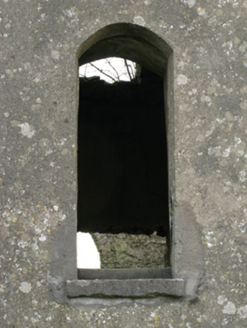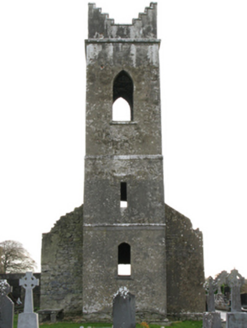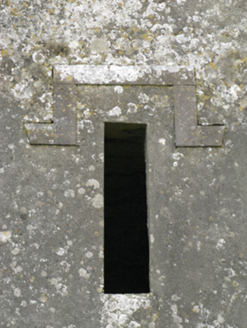Survey Data
Reg No
31312105
Rating
Regional
Categories of Special Interest
Architectural, Historical, Social
Original Use
Church/chapel
Date
1775 - 1780
Coordinates
118549, 259271
Date Recorded
16/12/2010
Date Updated
--/--/--
Description
Detached three-bay double-height single-cell Church of Ireland church, built 1778, with single-bay three-stage tower to entrance (west) front on a square plan. "Improved", 1812[?]. In use, 1911. Disused, 1945. In ruins, 1976. Roofs now missing. Rendered battered walls over coursed rubble limestone construction; rendered surface finish to tower with lichen-covered cut-limestone chamfered stringcourses including cut-limestone "Cavetto" stringcourse (bell stage) supporting crow stepped battlemented parapet having lichen-covered cut-limestone coping. Pointed-arch window openings including pointed-arch window opening to chancel (east) with cut-limestone sills, and hammered or squared limestone voussoirs with no fittings surviving. Segmental-headed window opening to tower (first stage) with cut-limestone sill, and concealed dressings with no fittings surviving. Square-headed "arrow loop" openings (second stage), concealed dressings with dragged cut-limestone "bas-relief" hood mouldings over. Pointed-arch openings (bell stage) with cut-limestone sills, and concealed dressings with no fittings surviving. Interior in ruins. Set in landscaped grounds with rendered piers to perimeter having lichen-covered shallow pyramidal capping supporting spear head-detailed wrought iron double gates.
Appraisal
The shell of a church representing an integral component of the later eighteenth-century ecclesiastical heritage of south County Mayo with the architectural value of the composition, 'a neat plain building [erected] about fifty-six years ago at the expense of [Sir John Browne (1726-94), first Baron Kilmaine]' (Parliamentary Gazetteer 1846 II, 514), confirmed by such attributes as the nave-with-entrance tower plan form recalling churches sponsored by the Board of First Fruits (fl. 1711-1833); the "pointed" profile of the openings underpinning a contemporary Georgian Gothic theme; and the crow stepped battlements embellishing the tower as a picturesque eye-catcher in the landscape.

















